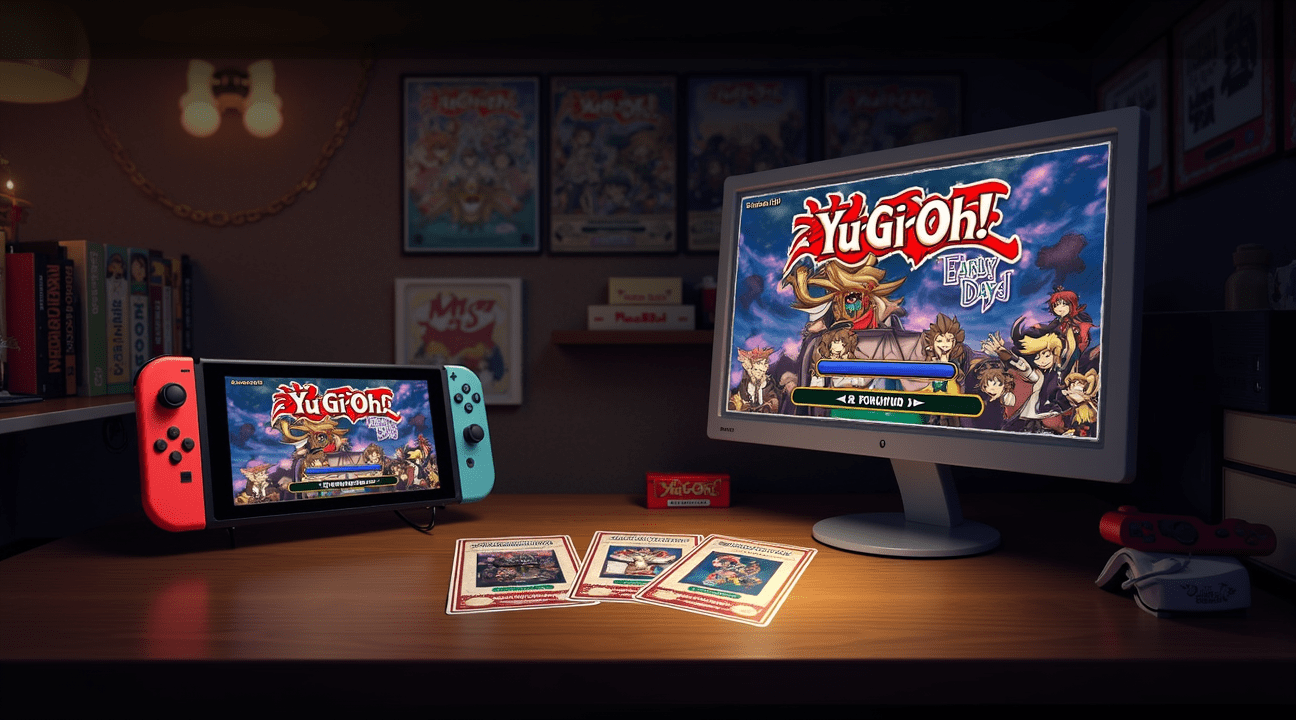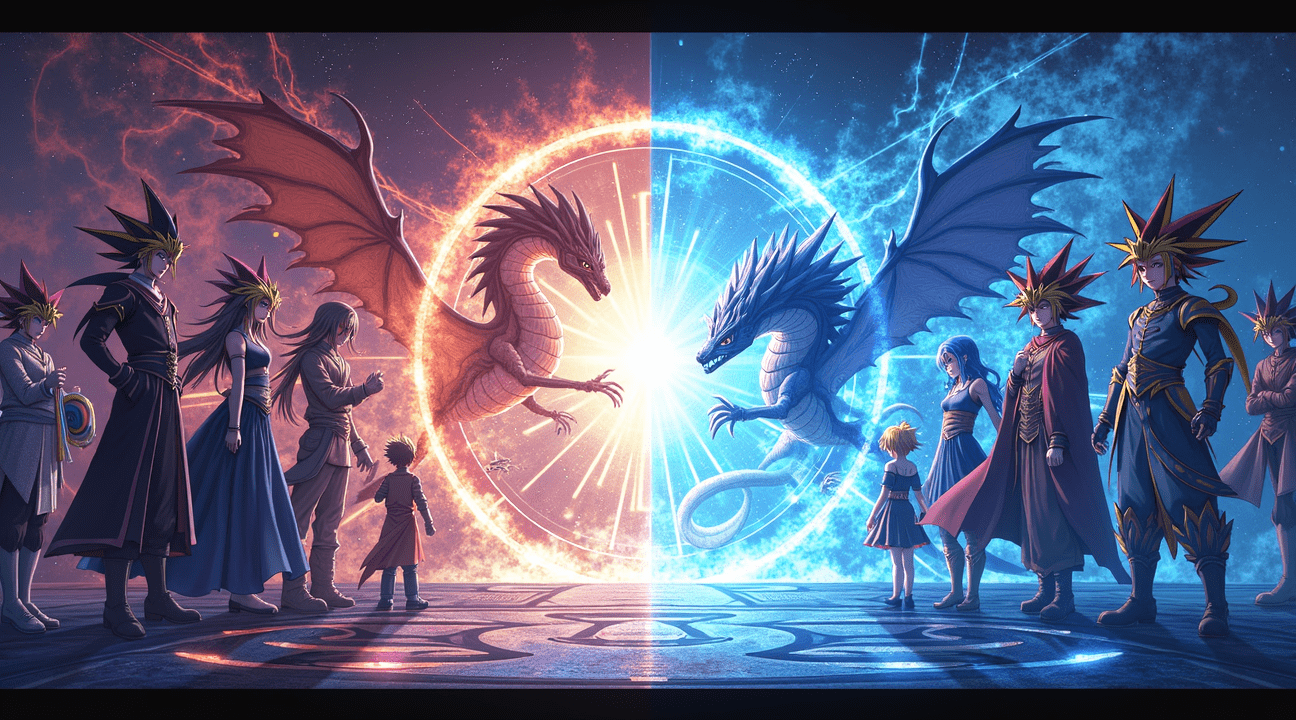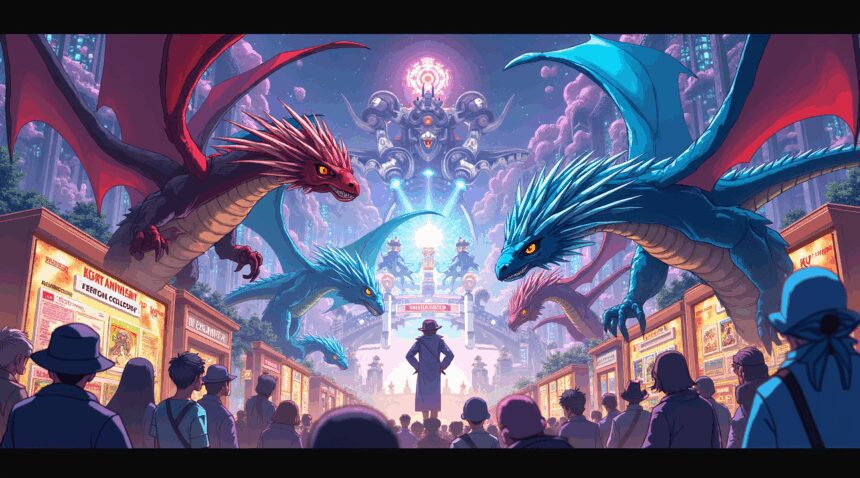Yu-Gi-Oh! dominates the trading card game industry while celebrating its 25th anniversary through strategic nostalgia marketing and record-breaking sales across global markets.
Key Takeaways
- Yu-Gi-Oh! has shattered sales records during its 25th anniversary celebration, with commemorative products like the Legendary Collection consistently selling out at major retailers while maintaining its position among the top-selling trading card games worldwide.
- Konami’s controversial unified errata changes have fundamentally altered classic card functionality across all formats, creating player tension as beloved cards like Goyo Guardian and Future Fusion now operate differently than their original designs.
- The Early Days Collection brings 14 classic Game Boy titles to modern platforms for $49.99, complete with exclusive physical cards, though it faces criticism for limited modernization and missing quality-of-life improvements.
- The archetype system successfully bridges nostalgia and competition by integrating iconic monsters like Blue-Eyes White Dragon and Dark Magician into modern tournament play, using support cards that preserve tradition while enhancing relevance.
- Industry recognition extends beyond card games through cross-promotional collaborations and technological ventures such as VR development by Konami, showcasing Yu-Gi-Oh!’s cultural influence and impact on broader entertainment and tech standards.
Yu-Gi-Oh! Shatters Sales Records While Celebrating 25 Years of Dueling
The trading card game industry continues to witness Yu-Gi-Oh!’s impressive dominance as it shatters sales records across global markets. I observe that this franchise consistently moves millions of products annually, cementing its position among the world’s best-selling trading card games while maintaining an exceptionally dedicated international fanbase.
Konami’s strategic approach to the 25th anniversary has proven remarkably effective in driving both nostalgia and sales. The company launched extensive commemorative product lines that blend classic appeal with modern collecting excitement. The Legendary Collection 25th Anniversary stands as a flagship release, bringing together iconic cards from across the game’s rich history in premium packaging that appeals to both veteran players and newcomers alike.
Quarter Century Commemoratives Drive Collector Frenzy
Quarter Century Secret Rare cards represent perhaps the most significant collector development in recent years. These special releases feature beloved classics like “Harpie’s Feather Duster” in stunning new treatments that command premium prices and generate substantial buzz within the community. I’ve noticed how these releases strategically tap into collector psychology, combining rarity with nostalgic appeal to create must-have items that drive sales spikes.
The anniversary celebration extends beyond product releases into competitive play innovations. Konami has expanded Time Wizard formats at major tournaments, including the prestigious North American World Championship Qualifier (NAWCQ). This expansion demonstrates the company’s commitment to honoring the game’s historical formats while providing fresh competitive experiences for players who want to revisit classic strategies and deck archetypes.
These developments showcase how Yu-Gi-Oh! continues evolving its approach to both casual collecting and competitive play. The anniversary strategy successfully leverages decades of accumulated goodwill while introducing new elements that keep long-time fans engaged. Tournament organizers have responded positively to format diversification, creating additional entry points for players with different preferences and skill levels.
Record-breaking sales figures reflect this multi-pronged approach’s effectiveness. Anniversary products consistently sell out at major retailers, while tournament attendance numbers show healthy growth across multiple formats. The combination of premium collectibles and innovative competitive structures has reinvigorated community interest and demonstrated that strategic nostalgia marketing can drive substantial business results without sacrificing game integrity or competitive balance.

Controversial Rule Changes Create Player Tension Between Old and New
Konami’s decision to implement unified errata across all formats has fundamentally altered how classic cards function, creating a significant divide in the player base. I observe that long-standing cards now operate differently than their original designs, forcing players to relearn strategies they’ve used for decades. Goyo Guardian exemplifies this shift perfectly—the once-versatile synchro monster now requires an Earth tuner specifically, drastically limiting its versatility in deck construction.
Errata Changes Reshape Classic Strategies
Future Fusion represents another striking example of how comprehensive errata updates have disrupted established gameplay patterns. The card’s altered effect prevents the rapid graveyard setups that defined many fusion-based strategies, essentially forcing players to rebuild their approaches from scratch. I find that these changes particularly impact competitive players who’ve invested years perfecting specific combos and interactions.
The controversy deepens with Konami’s mandate that current game mechanics apply even in Time Wizard side events as of mid-2025. Previously, these retro-focused tournaments allowed players to experience classic Yu-Gi-Oh gameplay without modern constraints, but that nostalgic experience has been effectively eliminated.
Standardized Rules Meet Player Resistance
Effect priorities and draw sequences now maintain consistency across all major formats, creating what Konami describes as a streamlined experience. The company argues this standardization reduces confusion when players transition between different tournament formats. However, I notice that veteran players express significant frustration with losing the unique characteristics that made classic formats distinct.
The ongoing speculation about potential new summoning mechanics or master rules adds another layer of uncertainty. Since the introduction of Link summoning represented the last major mechanical overhaul, many wonder if another paradigm shift approaches. Recent developments suggest that Konami continues exploring innovative gameplay elements, though nothing concrete has been confirmed.
Legacy tournament participants particularly struggle with these changes, as the formats they cherished for their historical accuracy no longer exist. Classic deck archetypes require complete reconstruction to accommodate modern errata, effectively erasing decades of established meta knowledge. Players who mastered intricate timing windows and priority chains from earlier eras must now adapt to contemporary interpretations of those same mechanics, creating an ongoing tension between preserving the game’s history and maintaining its competitive integrity.
Early Days Collection Brings Classic Gaming to Modern Platforms
Konami’s Yu-Gi-Oh! Early Days Collection marks a significant milestone in bridging the franchise’s rich gaming heritage with contemporary platforms. Released on February 27, 2025, this comprehensive compilation delivers 14 classic video games from the Game Boy to Game Boy Advance generations for $49.99 MSRP. The collection spans both Nintendo Switch and PC platforms, ensuring accessibility across multiple gaming ecosystems.
Game Selection and Physical Collectibles
The Early Days Collection showcases titles that defined the franchise’s early digital presence, offering players direct access to the formative gaming experiences that shaped Yu-Gi-Oh! TCG dynamics. Each copy includes exclusive physical cards designed specifically as collector incentives, adding tangible value beyond the digital experience. These bonus cards acknowledge the deep connection between the virtual and physical trading card game communities.
I find the collection serves dual purposes: introducing newcomers to the franchise’s roots while satisfying longtime fans’ desire for convenient access to classic titles. The physical card inclusion demonstrates Konami’s understanding that collectors value items extending beyond digital purchases.
Modernization Challenges and Player Expectations
Despite enthusiastic reception from nostalgia-driven fans, the collection faces criticism regarding limited modernization efforts. Several key concerns emerge from community feedback:
- Multiplayer functionality remains restricted compared to modern gaming standards
- Notable gaps exist where certain beloved games aren’t included in the compilation
- Original mechanics persist without quality-of-life improvements that contemporary players expect
- User interface elements haven’t received updates to match current gaming conventions
These limitations create friction for players seeking polished experiences that blend classic gameplay with modern conveniences. Newer players particularly struggle with outdated control schemes and interface designs that felt natural during the original release periods but now seem cumbersome.
The collection’s approach reflects broader industry debates about preservation versus modernization. While purists appreciate authentic recreation of original experiences, casual gamers often demand enhanced features that improve accessibility and usability. This tension becomes especially apparent when comparing the Early Days Collection to other franchise offerings like Yu-Gi-Oh! Master Duel updates that actively incorporate modern gaming expectations.
I believe Konami’s conservative approach prioritizes authenticity over enhancement, which serves dedicated fans but potentially alienates players expecting contemporary gaming features. The absence of modernized multiplayer options particularly limits the collection’s long-term appeal, as competitive gaming has become central to the franchise’s current identity.
The pricing strategy at $49.99 positions the collection competitively within the retro gaming market. However, the value proposition depends heavily on individual player priorities. Collectors and longtime fans find significant worth in both the nostalgia factor and physical card bonuses. Conversely, players seeking active gaming communities or cutting-edge features might question the investment.
Platform availability across Nintendo Switch and PC expands the potential audience considerably. Switch’s portable nature especially suits the handheld gaming origins of many included titles, while PC compatibility ensures broader accessibility and potential for community modifications or enhancements.
The collection’s release timing aligns with the franchise’s broader strategy of leveraging nostalgia while maintaining forward momentum. Recent developments like the Yu-Gi-Oh! collaboration with Adidas demonstrate how classic elements can be reimagined for contemporary audiences. The Early Days Collection takes a more conservative approach, preserving original experiences rather than reimagining them.
Player reception ultimately divides along generational lines and gaming preferences. Veterans appreciate the authentic recreation of formative experiences, while newcomers often struggle with dated mechanics and limited social features. This divide highlights the ongoing challenge facing classic game collections: balancing preservation with accessibility for modern gaming audiences.

Legendary Collection 25th Anniversary Recreates Yu-Gi-Oh! History
The Legendary Collection 25th Anniversary stands as a masterful celebration of Yu-Gi-Oh!’s rich history, bringing together the most treasured moments from the franchise’s quarter-century journey. Konami crafted this collection to include faithful reproductions of the classic packs that defined the game’s early era, featuring Legend of Blue-Eyes White Dragon, Metal Raiders, Spell Ruler, Pharaoh’s Servant, Dark Crisis, and Invasion of Chaos alongside iconic promotional cards that sparked countless duels.
Classic Cards Return with Premium Treatment
I find the collection’s card selection particularly impressive, as it showcases the legendary monsters that captured players’ imaginations from the very beginning. The Blue-Eyes White Dragon returns in special rarity formats, alongside the Red-Eyes Black Dragon and Dark Magician, each card receiving treatment that honors its status as a cornerstone of the game. The Egyptian God cards also make their appearance, rendered in premium rarities that reflect their mythical significance in both the anime and the trading card game itself.
These reproductions don’t simply reprint old cards—they elevate them with modern printing techniques while preserving the original artwork and design philosophy that made them special. The collection bridges the gap between vintage appeal and contemporary quality standards, creating products that satisfy both collectors seeking pristine versions of classic cards and players wanting to experience these legendary monsters in their original form.
Strategic Nostalgia Drives Market Success
Konami’s approach with this anniversary collection demonstrates how effectively nostalgia functions as both a marketing strategy and a genuine connection point with the community. The company understands that Yu-Gi-Oh! players carry deep emotional attachments to specific cards and moments from the franchise’s history, particularly those who experienced the original anime series or collected cards during the game’s explosive early growth.
The financial success of nostalgia-themed products like this collection proves remarkable, drawing purchases from multiple audience segments. Dedicated players who never stopped collecting view these products as essential additions to their collections, while lapsed players—those who may have stepped away from the game years ago—return specifically for these recreated experiences. I observe that these returning players often seek to recapture the excitement they felt during their childhood or teenage years, when opening booster packs held the promise of discovering powerful monsters and game-changing spells.
The TCG’s evolving landscape benefits significantly from this dual appeal, as nostalgia products serve as entry points for former players while providing current enthusiasts with premium collectibles. The success of such releases influences broader industry trends, encouraging other trading card games to explore their own historical catalogs for similar anniversary treatments.
Konami’s timing with the 25th Anniversary collection aligns perfectly with the franchise’s continued expansion into new media and collaborations, creating synergy between different aspects of the brand. The collection serves as a tangible representation of Yu-Gi-Oh!’s enduring legacy while supporting ongoing initiatives that keep the franchise relevant for new generations of players.
The market response to anniversary collections and reprint sets consistently demonstrates strong sales figures, with both online retailers and local game stores reporting rapid sellouts of premium nostalgia products. This pattern suggests that emotional connections to trading card games run deeper than simple gameplay mechanics, extending into personal memories and cultural experiences that transcend the cards themselves.
Archetypes Bridge Classic Characters with Modern Competitive Play
I’ve watched Yu-Gi-Oh!’s archetype system transform from a simple concept into a sophisticated framework that connects the game’s nostalgic roots with cutting-edge competitive strategies. These thematically and mechanically linked card groups—ranging from iconic Blue-Eyes and Dark Magician archetypes to modern powerhouses like Dragonmaid and Sky Striker—create an intricate web of synergistic gameplay that keeps both collectors and tournament players engaged.
The archetype system drives remarkable diversity in deckbuilding approaches and competitive metagame variety. Each archetype operates with its own unique mechanics and win conditions, fostering an environment where dozens of viable strategies can coexist in tournament play. This variety encourages ongoing product purchases as players seek to complete archetype synergies and optimize their deck builds. Konami has positioned archetypes as the primary engine for both game balance and commercial success, ensuring that players remain invested in acquiring new cards to support their chosen strategies.
Modern Support Revitalizes Nostalgic Favorites
Popular archetypes from the original anime series continue to receive regular support cards in modern sets, creating a fascinating blend of classic appeal with contemporary competitive strategies. The Dark Magician archetype exemplifies this approach perfectly—while the original card remains unchanged since 1996, recent support cards like Dark Magic Attack and Magician Navigation have elevated the strategy to competitive viability. Similarly, Blue-Eyes White Dragon has received extensive modern support through cards like Blue-Eyes Spirit Dragon and The White Stone of Legend, transforming a nostalgic favorite into a legitimate tournament contender.
This approach serves multiple strategic purposes for Konami. Legacy archetypes tap into powerful nostalgic connections that draw returning players back into the game, while modern support cards ensure these classic strategies remain relevant against contemporary threats. Yu-Gi-Oh TCG’s changing landscapes reflect this careful balance between honoring the past and embracing innovation.
The integration process presents ongoing challenges as the game accumulates decades of new summoning mechanics and complex interactions. Each new mechanic—from Synchro and Xyz summoning to Link and Pendulum mechanics—adds layers of complexity that newer players must master. Konami faces the delicate task of making learning accessible without compromising the strategic depth that experienced players demand.
Recent developments in the digital space have created new opportunities for archetype integration. Master Duel leaks frequently reveal how classic archetypes receive digital-first support before physical release, allowing for rapid testing and refinement of new strategies.
The archetype system’s success extends beyond gameplay mechanics into broader cultural impact. Cross-promotional opportunities, such as the recent Yu-Gi-Oh collaboration with Adidas, demonstrate how iconic archetypes translate into mainstream appeal. These partnerships leverage the recognizable imagery and emotional connections players have developed with specific archetypes over decades.
Competitive players appreciate how archetype support creates predictable yet evolving metagames. Each new set introduces potential shifts in archetype power levels, requiring constant adaptation and strategic refinement. This cycle maintains tournament interest while providing clear upgrade paths for casual players looking to improve their decks.
The archetype bridge strategy has proven particularly effective in maintaining player engagement across different skill levels. Casual players can enjoy playing with their favorite characters while gradually learning more complex interactions, while competitive players can exploit these same synergies at the highest levels of play. This dual appeal ensures that archetype releases generate broad market interest and sustained sales figures.
Konami continues refining this balance through careful power level management and strategic release timing. The company has learned to avoid overwhelming new players while providing enough complexity to satisfy tournament veterans, creating a sustainable model for long-term growth.

Gaming Industry Recognizes Yu-Gi-Oh!’s Enduring Cultural Impact
The gaming industry continues to acknowledge Yu-Gi-Oh!’s remarkable ability to balance its complex legacy with modern innovation. I’ve observed how the franchise maintains its position as a cultural phenomenon while adapting to contemporary gaming demands. This recognition extends beyond traditional card gaming, as evidenced by Yu-Gi-Oh!’s collaboration with Adidas, which demonstrates the brand’s influence across multiple entertainment sectors.
Industry experts consistently point to Yu-Gi-Oh!’s sophisticated mechanics as both its greatest strength and biggest challenge. The consensus among developers is that while the game already operates with considerable complexity, future updates may further alter deck construction or extra deck sizes to innovate without overwhelming new players. This delicate balance requires careful consideration of how each change affects both veteran duelists and newcomers entering the game.
Balancing Innovation with Accessibility
Improved accessibility versus complexity remains an ongoing challenge that I see affecting every major update. The need to merge historic and modern gameplay creates tension between preserving Yu-Gi-Oh!’s intricate history and making it approachable for newcomers. Game developers face the constant pressure of introducing fresh mechanics while maintaining the strategic depth that seasoned players expect.
Recent developments in Yu-Gi-Oh Master Duel leaks suggest that Konami actively works to address this balance through innovative card design and tournament formats. The company continues to demonstrate its commitment to honoring Yu-Gi-Oh creator’s legacy while pushing the game forward technologically.
Industry recognition also extends to digital innovations, with Konami’s announced Yu-Gi-Oh Duel Links VR development representing a significant technological leap. This advancement showcases how the franchise adapts to emerging gaming platforms while maintaining its core identity.
The Yu-Gi-Oh TCG’s changing landscapes reflect broader industry trends where traditional card games must evolve to compete with digital entertainment options. I notice how the game’s cultural impact resonates beyond its immediate fanbase, influencing other trading card games and digital gaming experiences. This enduring influence cements Yu-Gi-Oh!’s status as more than just a game—it’s become a cultural touchstone that continues shaping entertainment industry standards and practices.
Sources:
Konami, “YU-GI-OH! EARLY DAYS COLLECTION Delivers Nostalgic Duels on Nintendo Switch and Steam”
YouTube, “This Konami Rule Change Drama Is Getting out of Hand…” (2025)
YouTube, “HUGE NEWS FOR THE Yu-Gi-Oh 2025 NAWCQ & Time Wizard Events” (2025)
Yugiohmeta.com, “Time Wizard Rules Update” (2025)
YouTube, “These Nostalgic Yu-Gi-Oh Products Could Be Improved.”
Lordsofgaming.net, “Yu-Gi-Oh! Early Days Collection – A Nostalgic, Yet Flawed, Time Capsule” (2025)
YouTube, “Yu-Gi-Oh! Nostalgia Why do we keep buying it?”
YouTube, “What YuGiOh NEEDS in 2025…” (2025)


